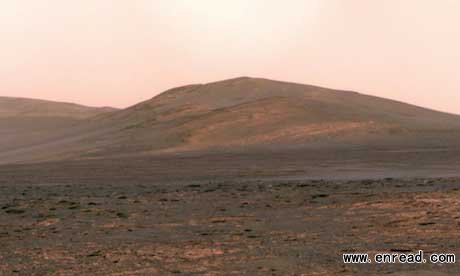| ||||||||||||||||||||||||||||||||||||||||||||||||||||||||||||||||||||||||||||||||
|
Opportunity has made one of its greatest scientific discoveries so far. Clay minerals in a rock called Esperance clearly indicate that neutral water flowed across the rock some time in the first billion years of its existence.
“机遇号”目前已实现了它的一项最伟大科学发现。一块名为“狮石”(Esperance)的岩石里,其中的粘土矿物表明在这块岩石最初的10亿年中的某个时刻时在,曾有中性水从它上面流过。
 After almost 10 years exploring, NASA's Mars Exploration Rover Opportunity will now head for Solander Point. The rock was found near Endurance Crater1, and took seven attempts to analyse because it was partially2 covered in Martian dust.
The clay minerals are similar to one called montmorillonite(蒙脱土). Formed under the influence of neutral water, this is significant because neutral water, which is similar to household tap water, is thought to be much more conducive3 to the chemistry needed for the origin of life.
Announcing the results, Steve Squyres, principal investigator4 for Opportunity, Cornell University, Ithaca, N.Y. said that, although they have talked in the past about finding water with Opportunity, really it was more like sulphuric acid.
As Mars turned into the desert planet we see today, so the water became more acidic. This happened because of evaporation5, which left a higher concentration of minerals in the remaining water – rather like reducing a sauce to make it richer.
Neutral water dates from an earlier time on the planet, when it rained frequently bestowing6 a more Earth-like environment.
Although a first for Opportunity, this is not the first time that neutral water has been found on Mars. In March, NASA's larger, younger rover Curiosity found evidence for 'drinkable' water in clay minerals in Gale7 crater. "It is really striking to me, how similar the stories are for the rocks at Gale and Endeavour crater," says Squyres, comparing the two findings.
Opportunity is now heading for a 55-metre high outcrop called Solander Point. Averaging 50 metres per day, the team hope to get there before August.
Winter is approaching on Mars. If Opportunity reaches Solander Point's sloping sides, the solar panels can catch more of the low winter Sun. This could give them enough power to drive during the winter months.
In previous Martian winters, on flatter terrain8, power levels have dropped so much that engineers have had to park Opportunity and wait for the cold weather to end.
Images show that Solander Point displays layered terrain. These layers preserve a record of Mars's changing climate throughout the planet's history, which Opportunity can read. Analysing such layers is similar to Curiosity's mission at Mount Sharp in Gale crater.
The longevity9 of Opportunity is astonishing. Designed to last for just 90 Martian days, it is now approaching its 3400th Martian day of operation.
It has lasted almost 40 times longer than its design lifetime. It was launched on 7 July 2003 and landed on 25 January 2004.
点击  收听单词发音 收听单词发音
|
||||||||||||||||||||||||||||||||||||||||||||||||||||||||||||||||||||||||||||||||
上一篇:英国艺术家发明手套耳麦 下一篇:瑞典发明汗水提取机 汗水变饮用水 |
||||||||||||||||||||||||||||||||||||||||||||||||||||||||||||||||||||||||||||||||
TAG标签:
water
Mars
opportunity
- 发表评论
-
- 最新评论 进入详细评论页>>



